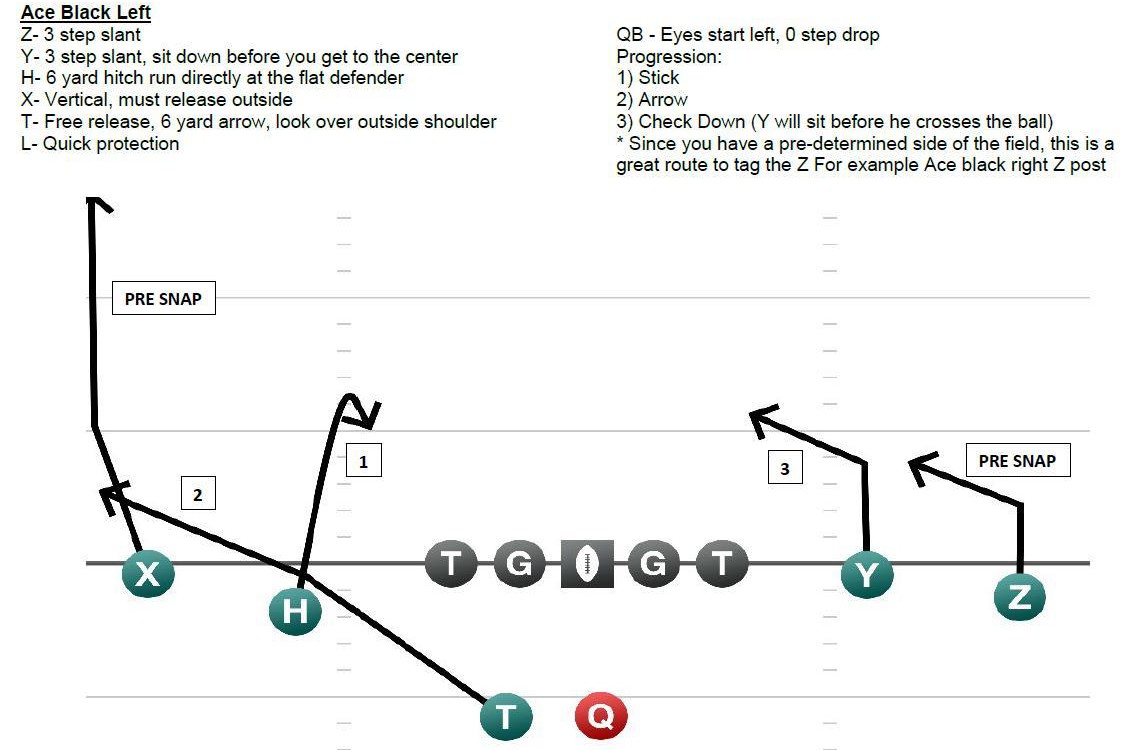BLACK – The Stick/Arrow Concept
Black – The Stick Arrow Concept

In the traditional Air Raid, this route is called Stick or Stick Arrow. We call it “BLACK.” (I explained this in an earlier post, but we use colors to help with communication. It reduces verbage and also makes it really easy for linemen as every color means Quick Protection).
But, whatever you call the route, it will probably become one of your favorite quick game routes for two reasons. 1) The Stick Arrow Concept works against zone or man 2) It’s a really easy throw for any QB. A 112 pound Freshman QB can throw this route. So, let’s look at a couple coaching points on the stick arrow concept that may help you as you install it.
1) The Stick, for all intents and purposes is a 6 yard hitch, but it is much more nuanced than a simple stop route. The key to this route is to run directly at the inside shoulder of the flat defender. This can be tough for kids, which is why you have to do a great job with your scouting report. The flat defender is most likely the outside linebacker, but it could also be a strong safety or free safety depending on the defense. The key to the route is to run right at his inside shoulder for 6 yards. Sometimes he will just sit there and what for you. Then its easy. Run right at him, turn around and look for the ball. But, he could also take off sprinting toward the flat. In that case, you have to follow him until you reach 6 yards, then turn around and get big. If it’s man, you should post up and give the QB a target hand away from the defender.
***I love to run the stick route with my biggest and strongest receiver. Its like feeding the post player in basketball.
2) The Arrow route is a straight shot at the sideline 6 yards from the line of scrimmage. The back (or slot, if you are running it out of trips) should look over his outside shoulder as soon as he crosses the line of scrimmage. A coaching point here is to have you back cheat up one yard and out one yard from his normal alignment. He should align half a yard in front of the QB and directly over the tackle. This will mirror his alignment for a sweep or a stretch play.
3) On the stick arrow concept, The backside slot receiver runs a slant, and sits down before he crosses the ball. Essentially, he replaces the check down that is usually run by a back.
4) The QB progression on the stick arrow concept is Stick, Arrow, Check Down. Basically, you are putting the flat defender on an island and making him choose between your slot and your back. Here is the number 1 coaching point for your QB. If the stick is open, you have to throw it. Because, if the stick is open the arrow won’t be. The number 2 coaching point, and this goes for the entire offense, is that once you come off the stick, you can’t come back to it. Coming back to a primary read is a recipe for an interception by an undercutting linebacker. Throw the stick away from the defender so your receiver can turn up field. If you throw the arrow route, be sure to hit the upfield shoulder.
***If you are so inclined, you can give your QB quite a bit of freedom here to throw a fade to the playside WR or a slant to the backside WR. If I have good QB and a receiver I trust, I let them signal a tagged route on the backside of Black. Or, I may call a tagged route. For example, Trips Right Black X Post or Ace Black Left Z Comeback.
If we tag a route the rule is very simple. If they play our tagged WR 1 on 1, then we throw the tagged route. If they have a safety over the top, then we work our Black progression.
***Cover 2 can present a problem for this route because the arrow runs right into the squatting CB. So, if the Defense takes away the stick, the route is dead. If you know you have a cover 2 team, I would call White (all stops) instead of Black. You can find this route in your Win With The Pass playbook.
I love the stick arrow concept! It is one that we can always execute, no matter how strong or weak our QB’s arm is. It is usually the first Quick game concept I install and also usually my first play of the game. I have literally called this play 5 times in a row with different tags attached each time, forcing the defense to make a decision about how they are going to cover us. If you teach the nuances, you will have a lot of success with this play.

